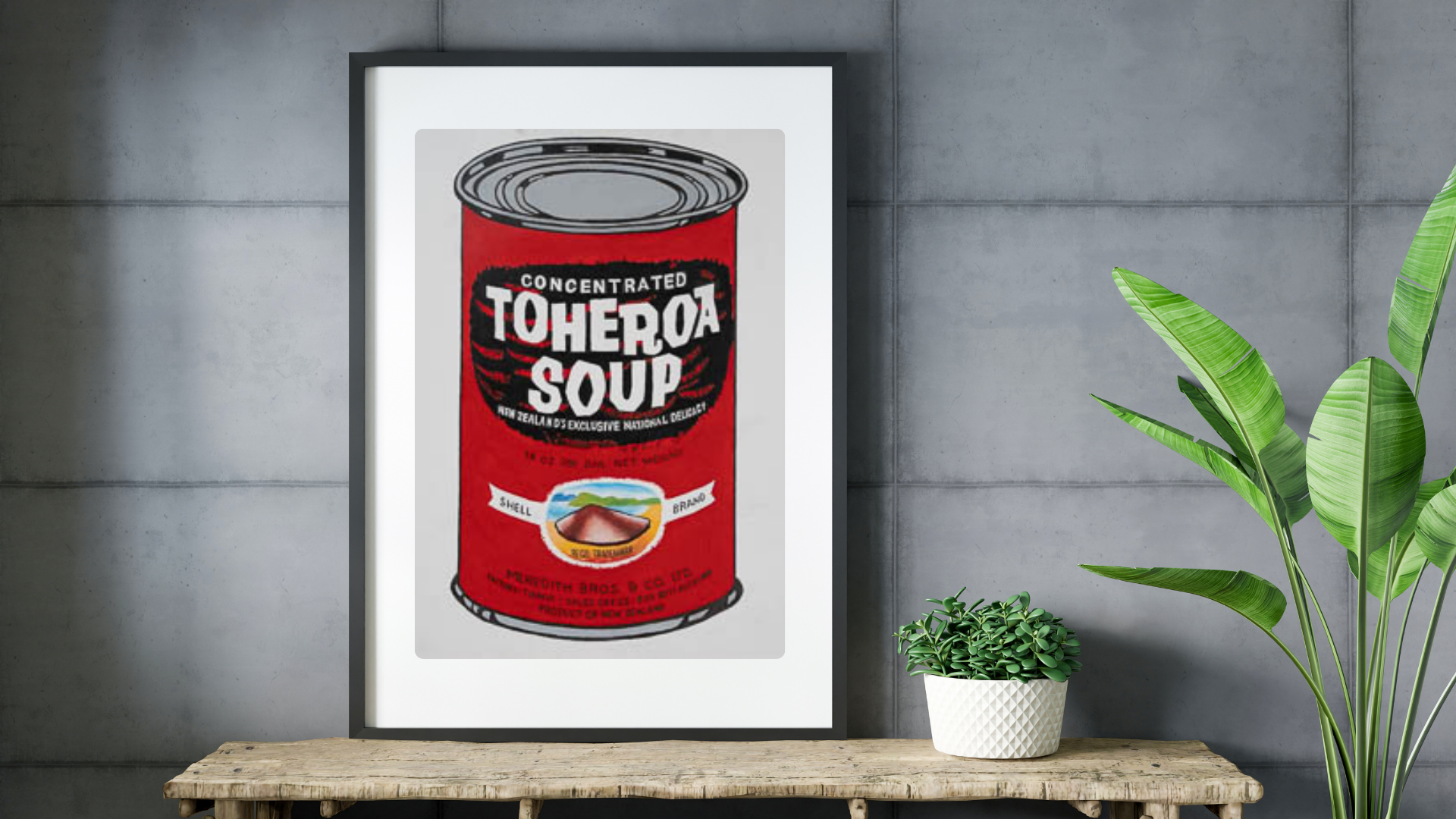 Image 1 of 4
Image 1 of 4

 Image 2 of 4
Image 2 of 4

 Image 3 of 4
Image 3 of 4

 Image 4 of 4
Image 4 of 4





Toheroa Soup
2023
Graeme Lee Main
After
Campbell's Soup Cans by Andy Warhol. (1962)
Warhol created his 32 Soup Cans for his first solo exhibition and they are now perhaps the most famous example of Pop Art. I wanted to produce a uniquely New Zealand version and as soon as I saw an image of the Toheroa Soup Can, knew this was the image to fit perfectly. This was my first painting since leaving high school.
At first glance, toheroa soup seems an unlikely food phenomenon, as when the shellfish are boiled it results in an unusual, khaki-green broth, coloured by all of the phytoplankton they eat. But this green soup was highly admired. It had a delicate flavour that was easy on the stomach but nourishing and invigorating at the same time. Both Maori and earlier settlers enjoyed them in abundance and the soup was enjoyed by visiting royalty, sparking an explosion of industry around the beaches of the west coast of Northland. In the 1950s and 1960s, with more New Zealanders having access to cars, it became popular to drive to the beach to collect toheroa. In 1966, at Glinks Gully in Northland, around 50,000 people turned up and harvested over a million toheroa in one weekend. I do remember as a child digging in the Black sands on the West Coast, but as I’m allergic to shellfish, never indulged.
This over-harvesting was of course unsustainable and they were pushed to the brink of extinction. The harvesting of Toheroa for the general public was outlawed in the 1990s but they are still struggling to recover. For Māori, the loss of toheroa - an important food source for hapū and iwi has had a profound impact. 'The Politics of Toheroa Soup' follows tangata whenua, hapū and iwi who are on a journey to revitalise and rebuild toheroa populations.
Acrylic on Canvas board and reproduced in Ink on Ilford Galerie Fine Art Paper.
2023
Graeme Lee Main
After
Campbell's Soup Cans by Andy Warhol. (1962)
Warhol created his 32 Soup Cans for his first solo exhibition and they are now perhaps the most famous example of Pop Art. I wanted to produce a uniquely New Zealand version and as soon as I saw an image of the Toheroa Soup Can, knew this was the image to fit perfectly. This was my first painting since leaving high school.
At first glance, toheroa soup seems an unlikely food phenomenon, as when the shellfish are boiled it results in an unusual, khaki-green broth, coloured by all of the phytoplankton they eat. But this green soup was highly admired. It had a delicate flavour that was easy on the stomach but nourishing and invigorating at the same time. Both Maori and earlier settlers enjoyed them in abundance and the soup was enjoyed by visiting royalty, sparking an explosion of industry around the beaches of the west coast of Northland. In the 1950s and 1960s, with more New Zealanders having access to cars, it became popular to drive to the beach to collect toheroa. In 1966, at Glinks Gully in Northland, around 50,000 people turned up and harvested over a million toheroa in one weekend. I do remember as a child digging in the Black sands on the West Coast, but as I’m allergic to shellfish, never indulged.
This over-harvesting was of course unsustainable and they were pushed to the brink of extinction. The harvesting of Toheroa for the general public was outlawed in the 1990s but they are still struggling to recover. For Māori, the loss of toheroa - an important food source for hapū and iwi has had a profound impact. 'The Politics of Toheroa Soup' follows tangata whenua, hapū and iwi who are on a journey to revitalise and rebuild toheroa populations.
Acrylic on Canvas board and reproduced in Ink on Ilford Galerie Fine Art Paper.
2023
Graeme Lee Main
After
Campbell's Soup Cans by Andy Warhol. (1962)
Warhol created his 32 Soup Cans for his first solo exhibition and they are now perhaps the most famous example of Pop Art. I wanted to produce a uniquely New Zealand version and as soon as I saw an image of the Toheroa Soup Can, knew this was the image to fit perfectly. This was my first painting since leaving high school.
At first glance, toheroa soup seems an unlikely food phenomenon, as when the shellfish are boiled it results in an unusual, khaki-green broth, coloured by all of the phytoplankton they eat. But this green soup was highly admired. It had a delicate flavour that was easy on the stomach but nourishing and invigorating at the same time. Both Maori and earlier settlers enjoyed them in abundance and the soup was enjoyed by visiting royalty, sparking an explosion of industry around the beaches of the west coast of Northland. In the 1950s and 1960s, with more New Zealanders having access to cars, it became popular to drive to the beach to collect toheroa. In 1966, at Glinks Gully in Northland, around 50,000 people turned up and harvested over a million toheroa in one weekend. I do remember as a child digging in the Black sands on the West Coast, but as I’m allergic to shellfish, never indulged.
This over-harvesting was of course unsustainable and they were pushed to the brink of extinction. The harvesting of Toheroa for the general public was outlawed in the 1990s but they are still struggling to recover. For Māori, the loss of toheroa - an important food source for hapū and iwi has had a profound impact. 'The Politics of Toheroa Soup' follows tangata whenua, hapū and iwi who are on a journey to revitalise and rebuild toheroa populations.
Acrylic on Canvas board and reproduced in Ink on Ilford Galerie Fine Art Paper.